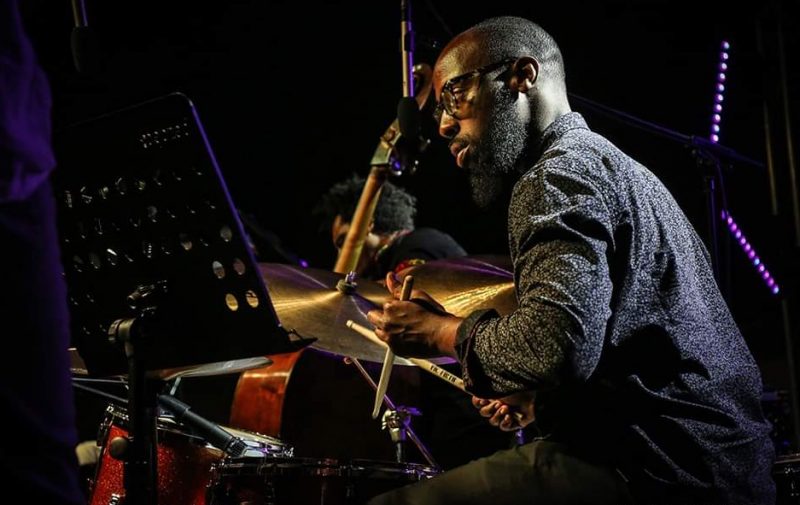Anwar Marshall, Nate Smith, Kassa Overall, and Karriem Riggins on merging the digital and live worlds in their beat
Swing or play straight? Push or lay back? Not so long ago, decisions about groove were fairly straightforward, almost set-and-forget. Now look: Every groove can be mapped and re-mapped, tweaked from beat to beat through menus and submenus, massaged with software plug-ins that dial in the precise levels of “humanity” that might be desired in a programmed groove. Want more hiccup? Want a longer hiccup?
These computer-age tools have accelerated the evolution of loop-based music, and helped renew reverence for the pioneering work of such early hip-hop beatmakers as the late J Dilla, who stretched time without the benefit of software. Their deep, granular options have swept through all genres of music, and they’ve created a kind of arms race among those working in improvised music: Suddenly, the most hotly contested/debated ideological zone is the space between downbeats.
“You have guys who are sometimes imitating the precision of the beat machine on the kit, and then imitating the way Dilla made the beat glitch out,” observes drummer/producer Anwar Marshall, who’s worked with Orrin Evans, Pat Metheny, and a number of hip-hop artists. Marshall says it can be tricky to evoke the “drunk” or circuit-bent ethos of Dilla-style programmed beats in an improvisational context, in part because the drummer has to conceptualize the feel in a limb-by-limb way.
“Once you put those aspects together, certain elements of the rhythm don’t line up. … [F]or a drummer, that means each limb has to be playing a different feel. Stuff is ahead and behind at the same time. The hi-hat might be ahead but the kick is laid-back. And what’s happening on the snare might be somewhere in between.”
Marshall is among a wave of timekeepers who are meshing the rhythmic devices of jazz, hip-hop, and electronic music into a mutable, reactive syntax. Through their playing and (even more directly) their production work, they seek open and endlessly regenerative approaches to rhythm: subdividing in asymmetrical bursts, ditching the computer’s quantization options that neatly align every beat, organizing compositions not in the head/solo configuration of bebop but the discursive through-composed approach of contemporary classical music.
Some use plain old acoustic kits, some prefer elaborate sampling rigs built around the Akai MPC, and some work with hybrid setups that depend on sensitive triggers. All, though, are fracturing previously binary ideas—swing or straight?—into time feels that explore many possibilities at once, in ways that challenge everyone involved. This kind of innovation, a hybrid of performance practice and studio-centered programming, could only start with the drum.
“Of course it’s the drummers opening up that space,” laughs Nate Smith, whose résumé includes work with Dave Holland and Brittany Howard of Alabama Shakes, his own productions (including the current Light and Shadow EP, which features his writing for strings), and a set of loop libraries for the Loop Loft. “It has to be, because the drums are the engine, and [we’re] the ones whose job it is to make sure things feel good. In a physical sense.”
Inspired by Dilla and the Roots’ Ahmir “Questlove” Thompson, these drummers—including Karriem Riggins, Marcus Gilmore, Kassa Overall, Mark Guiliana, Brian Blade, Antonio Sánchez, and Kendrick Scott, as well as Marshall and Smith—have developed unusual tactics to loosen the grip of the repetitive DAW (Digital Audio Workstation) grid, and in the process create stretchy, elastic pulses that, well, feel good.
Most have worked in acoustic small-group jazz at a high level, and have also done for-hire productions that require programming knowledge. The combination of those seemingly disparate skillsets can be diabolical: Gilmore, whose grandfather is legendary drummer Roy Haynes, does a completely live solo version of David Virelles’ “Nube”—you can find it on YouTube—that juxtaposes thrillingly precise drum phrasing with triggered drones and melodic elements. It’s a demo for sensor technology that feels like a portal into a new realm.
Riggins, the Detroit drummer/producer who was among the first to translate J Dilla’s aesthetic to the live kit, maintains that Elvin Jones, also Detroit-born, is a forefather of this current rhythmic revolution. “Elvin deserves a lot of credit for the way we hear music,” he told Modern Drummer in 2019. “There are so many different nuances and so much syncopation in his playing, and that influenced Dilla. Dilla found what some would call the flaw or mistake, and made it the song.”
Conceptualists as much as timekeepers, these artists shape their projects from the early brainstorming stage; Marshall’s collaboration with Philadelphia MC Khemist began with several sessions of voice-and-drums freestyle jamming that the two later developed into the material on the new Khemtrails.
“The hi-hat might be ahead but the kick is laid-back. And what’s happening on the snare might be somewhere in between.” – Anwar MarshallKassa Overall, who describes himself as a “backpack producer,” spent years supporting and inspiring the late pianist Geri Allen. For his recent I Think I’m Good, which came out shortly before the pandemic erupted, he recorded as a nomad, capturing soloistic sparks on his laptop in the home studios of Sullivan Fortner, Joel Ross, and Theo Croker (among others). Though he gathered lots of audio, he says he spent most of the time on the project alone, obsessing over tiny micro-editing tasks for hours: “When I show other producers my session files, with like eight hours of me snipping hairs off a hi-hat part, they go, ‘Okay, you are literally insane.’”
Thing is, that painstaking detail work—essential to hip-hop masterworks by Public Enemy and others—is not always audible. The true innovations on many of the records in this realm, by Overall and Flying Lotus and Robert Glasper, exist layers beneath the surface, embedded into the rhythmic latticework. And they’re not tricks; they’re part of the fuel that makes the tracks move.
“What you’re seeing now is the awareness of groove that is tied closely to the song,” Smith says, arguing that many of his peers are finding new balances between free-form journeying and more orderly compositional frameworks. “It’s not about playing lots of stuff, or wearing a fur coat of technique. … [A] lot of it comes from the stuff we do in jazz in a support role, like snare drum comping.”
For that reason, it’s tempting to describe these devices as a musical “language.” But languages have rules and formulas, and on both micro and macro levels, the stretching that Smith and others are doing amounts to a subversion of order. They’re injecting messy interaction into the works, disrupting the pulse as it sits on a computer grid that, until recently, was the producer’s absolute arbiter of groove. At the same time, they’re unraveling the comfortable thinking that the grid reinforces. In the eternal struggle of man against machine, their randomized speeding up, slowing down, and glitching out is both brilliant improvisation and a form of defiance.
Published November 11, 2020 – By Tom Moon







